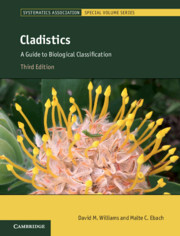Book contents
- Cladistics
- The Systematics Association Special Volume Series
- Cladistics
- Copyright page
- Dedication
- Contents
- Preface
- Acknowledgements
- Introduction: Carving Nature at Its Joints, or Why Birds Are Not Dinosaurs and Men Are Not Apes
- Part I The Interrelationships of Organisms
- Part II Systematics: Exposing Myths
- 3 Relationship Diagrams
- 4 Essentialism and Typology
- 5 Monothetic and Polythetic Taxa
- 6 Non-taxa or the Absence of –Phyly: Paraphyly and Aphyly
- Part III The Cladistic Programme
- Part IV How to Study Classification
- Part V Beyond Classification
- Afterword
- Index
- Systematics Association Special Volumes
- References
5 - Monothetic and Polythetic Taxa
from Part II - Systematics: Exposing Myths
Published online by Cambridge University Press: 20 July 2020
- Cladistics
- The Systematics Association Special Volume Series
- Cladistics
- Copyright page
- Dedication
- Contents
- Preface
- Acknowledgements
- Introduction: Carving Nature at Its Joints, or Why Birds Are Not Dinosaurs and Men Are Not Apes
- Part I The Interrelationships of Organisms
- Part II Systematics: Exposing Myths
- 3 Relationship Diagrams
- 4 Essentialism and Typology
- 5 Monothetic and Polythetic Taxa
- 6 Non-taxa or the Absence of –Phyly: Paraphyly and Aphyly
- Part III The Cladistic Programme
- Part IV How to Study Classification
- Part V Beyond Classification
- Afterword
- Index
- Systematics Association Special Volumes
- References
Summary
How are taxa defined? How should they be defined? Should they be defined at all? In this chapter we discuss two approaches to the formation of groups, captured by the notions of polythetic and monothetic classes.
- Type
- Chapter
- Information
- CladisticsA Guide to Biological Classification, pp. 119 - 123Publisher: Cambridge University PressPrint publication year: 2020

